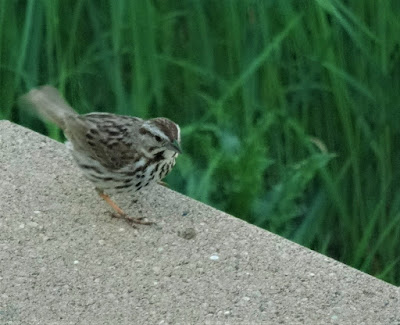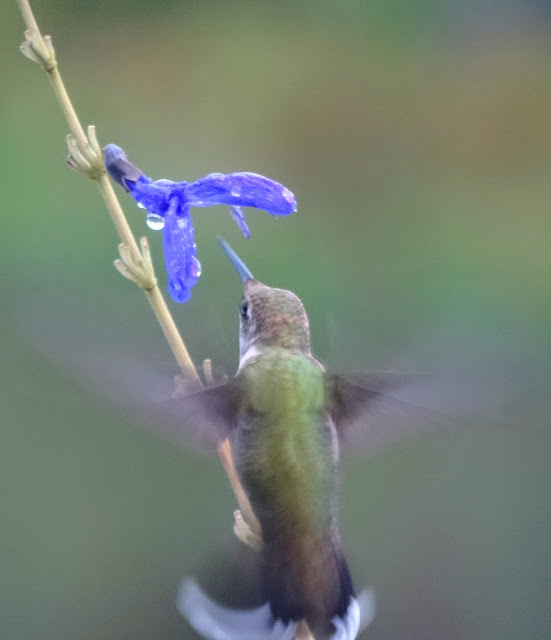8/10/2023
green heron
7/30/2023
molting woodpecker
Mullein blooms over a long time in the summer. Some of the flower stalks have produced seeds. Birds molt old feathers and grow new ones after nesting and fledging their young. This Downy Woodpecker has a few more new feathers to sprout, but it is hungry enough to come out for lunch.
7/17/2023
fledgling robin
6/16/2023
killdeer
Killdeer Charadrius vociferus is a shorebird that is part of the plover family. About the size of a American Robin, it has very long legs and striped black and white neck. It usually inhabits grassy areas but eats mostly invertebrates. This one was foraging along the shore for aquatic insect larvae. The scientific name "vociferus" is from Latin; 'vox' meaning "voice" with 'ferre' meaning "to carry". Their call is surely carrying! https://musicofnature.com/mary-holland/killdeer/
5/26/2023
song sparrow
Song Sparrow Melospiza melodia live up their binomial nomenclature 'melodia' by singing a delightful song, enthusiatically, and often.
They move along wetland edges like around the pond. I see the males occasionally, but they spend most of the time in dense, low vegetation.
5/21/2023
5/09/2023
pair of blue winged teal
5/03/2023
sandpipers
4/27/2023
yellow-rumped warbler
Yellow-rumped Warblers Setophaga coronata arrived here on the pond today on migration to the northern part of Minnesota and Canada, where they will nest and breed young birds. Also called "Myrtle" Warblers. On migration they eat fruits and seeds. Here, they flit along the shoreline hunting insects among the grasses. These individuals came to the feeders to eat thistle and sunflower chips. When more insects appear and the Warblers arrive on the breeding ground up north, they will eat caterpillars and other larvae, small beetles, weevils, ants, scale insects, aphids, grasshoppers, caddisflies, spiders, and gnats.
4/25/2023
northern shovelers in Spring
Northern Shovelers visited the pond today. They eat tiny crustaceans, other aquatic invertebrates, and seeds in and around the pond. To filter food out of the water, they have comb-like projections (called lamellae) along the edge of their bills. Lamellae are slightly pliable. They help many ducks, gooses, and other birds eat by filtering edible items from mud or water.
4/20/2023
hooded mergansers in Spring
We have three types of Mergansers in North America. The smallest of the group is the Hooded Merganser. These are diving ducks; their long bills are slender with serrated edges, formed like teeth for grasping and holding their prey. They dive in lakes or ponds, staying under water up to two minutes, while hunting for small fish, crustaceans, amphibians, or roots.
4/16/2023
blue-wing teal in Spring
1/30/2023
tree sparrow
American Tree Sparrows come to the feeders often in winter. Spizelloides arborea Tree Sparrows often fluff out their feathers. A rusty cap makes them look like chipping sparrows, who migrate south of Minnesota for winter. These little birds come 'south' to the northern US for winter. In spring, they breed in the far north tundra in Canada (near the tree line) building nests on the ground, often in a tussock of grass. They sport a rusty eyeline, a brown back, and dark smudge in the center of the smooth breast.
11/25/2022
11/04/2022
9/19/2022
7/23/2022
young blackbird showing epaulets
This young male Red-winged Blackbird was begging his mom to give him food from the seed feeder. I can tell he is a male because he's already starting to get his bright colored 'epaulets' on his shoulders. She has been putting food in his mouth whenever he gapes since he hatched out of his egg. But now that she is hoping he will find his own food!
7/03/2022
mallard families
Female Mallard came out of the grasses with her 3 young ducks (upper right). Then, another Mallard appeared with her 8 younger ducklings. They were all intent on eating duckweed and other aquatic plants growing in the pond.
6/28/2022
On 5/20/2022 we peeked into the nest box, and found several eggs. Not countable, because of the feathers in the box meant to hide the eggs from predators. Since then I have peeked several times more.
5/12/2022
sora, master of disguise
My new favorite bird! I just discovered the Sora Porzana carolina (a very secretive wetland bird) this Spring. I watch a pair every day, hunting at the edge of the pond. They think the mottled-pattern camouflage feathers makes them hard to spot. But the bright yellow bill gives them away. (see post on 4/24/2022)





















